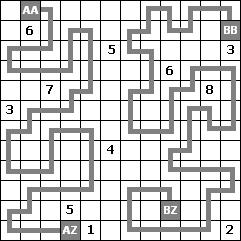Puzzle # 10: Snakes
|
|
2 |
|
|
|
|
|
|
|
|
|
4 |
|
AA |
2 |
|
|
5 |
|
|
|
6 |
|
6 |
|
|
|
|
|
|
|
|
|
|
|
|
|
|
|
|
|
|
|
|
5 |
|
|
|
|
7 |
|
|
0 |
|
|
|
|
|
1 |
|
|
|
|
|
|
|
|
|
|
|
|
4 |
4 |
|
|
|
|
|
BB |
|
|
4 |
|
|
|
|
|
|
|
|
|
|
|
2 |
|
|
|
|
|
|
|
|
0 |
|
|
|
|
|
|
|
|
|
AZ |
|
5 |
6 |
|
|
|
|
|
|
2 |
|
|
|
|
|
|
|
|
|
|
|
|
|
|
|
5 |
|
|
|
|
|
2 |
|
|
|
3 |
|
|
|
4 |
|
|
|
4 |
|
|
|
|
|
|
|
|
|
|
|
|
|
|
|
|
|
4 |
|
|
|
7 |
|
|
2 |
|
|
|
|
|
0 |
|
|
|
|
BZ |
|
|
|
|
|
|
5 |
|
|
|
|
|
|
|
|
|
2 |
|
|
|
|
|
|
|
|
4 |
|
|
|
2 |
|
|
|
|
3 |
|
|
|
|
5 |
|
|
|
|
|
|
Two snakes are hidden in the table above.
The
snakes are formed by the combination of horizontal and vertical cells.
Each of snakes can touch itself but can't intersect itself.
The snakes can not touch
each other even diagonally.
The numbers in the cells show how many part(s) of
the snake(s) are included by
the neighbour cells which vertically, horizontally
and diagonally touch to these cells.
The snakes can't take part at the cells
containing a number.
The heads and the tails of the snakes are the gray cells.
Find out the hidden snakes.
If the answer of the example is
1911 , enter the
answer of the puzzle to be found with the same logic.
Example :

Answer :
1911
(129+810+37+89+810+36)